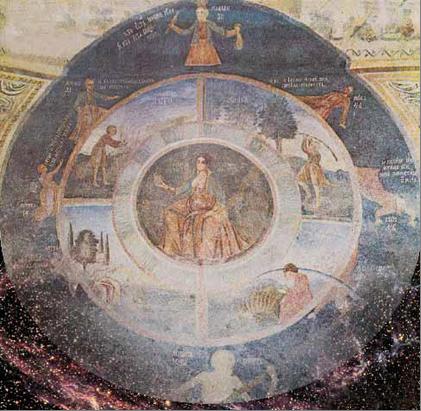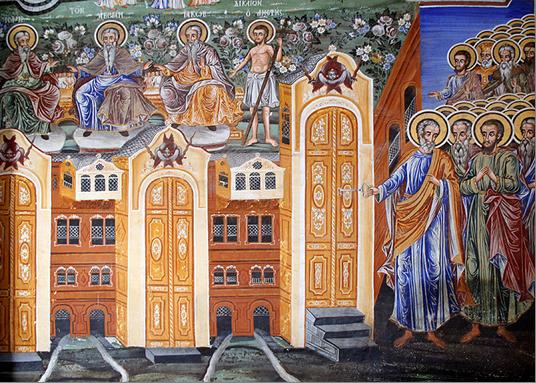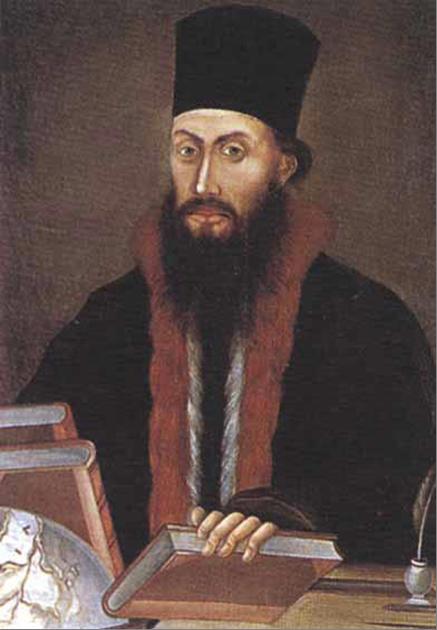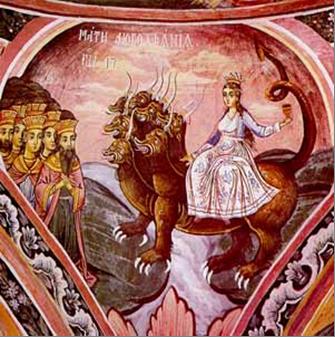
Reserved Area
Artists - ArtWorks
Zahari Zograf
 Bulgaria
BulgariaDevelopment of the Bulgarian revival
Development of the Bulgarian revival. Zahari Zograf works for about 20 years – from the end of the 20ties until 1853.
Zahari Zograf is arguably the most famous Bulgarian painter of the Bulgarian National Revival, noted for his church mural paintings and icons and often regarded as the founder of secular art in Bulgaria due to the introduction of everyday life elements in his work. He continues the traditions of Bulgarian art as a whole and in particularly those of the Samokov art school /of which he is a representative/. Historically, this is the period of the mature Bulgarian revival and the end of the Ottoman reign. This is the time when active processes of national /political, religious and cultural/ independence of the Bulgarians start.
Zahari Zograf acquires primary education in the monastery school at Samokov. He studies icon-painting and mural painting with his bigger brother – the well known icon-painter Dimitur Zograf. His main mentor is Neophit Rilski – a prominent writer and supporter of the Bulgarian national revival. Neophit Rilski helped him to form his perceptions of the world and prepared him as a future patriot and enlightener. This type of idealistic and artistic communication between politicians and artists is characteristic for many Bulgarians during the revival period. This communication replaces academic education, since such is not provided in Bulgaria at that time. Zahari Zograf wanted to study in the Petersburg art academy, but was not given the opportunity.
Zahari Zograf is a painter-monumentalist and like the other artists of his time he works in the sphere of church murals. He breaks the traditional manner of work and introduces principally new elements. His art is abundant and geographically scattered. He introduces originality in the use of traditional approaches when creating his murals in the Bachkovo, Rila, Troyan and Transfiguration monasteries. His art is not abstract, but is focused on his contemporaries, life and the society. It is also educational in comparison to the art of the other artists of that time. There are similarities between his icons and the icons of other contemporary masters from the Tryavna and Samokov art schools.
In the murals created at a number of monasteries, the artist conventionally refers to the traditional rules, by preserving the speculativeness, which so characteristic of religious art in principle. His searches in this field are characterized with interest in the plains and space, the placement of human figures in the composition, the urge to create portraits, life situations, to introduce fantastic and fairy tale elements. The scene “Doomsday” in Bachkovo monastery is interesting with its social nature – the rich go to hell. This is characteristic also of his other works – he presents Biblical topics as life-scenes in hard genre compositions. The murals in the Troyan monastery very strongly demonstrate his talent as decorator and colorist, which fills up the traditional scenes with a feeling of joy and happiness. Characteristic for these murals is the educational focus. The murals in the Transfiguration monastery continue his searches but in a synthesis with his achievements. He takes art into the open, which is innovative. He introduces additional architectural details and colors in the exterior of the façade of the building. Remarkable is the “wheel of life” – a contemplation on the transience of human life and the destiny of man. He introduces images of Russian saints and martyrs in harmony with the revival ideal. As an icon-painter he introduces a new artistic method. He preserves the frontal character of the composition, but introduces individual presentation of the characters. His main mean for expression is the color, with which he shapes up size and form. His icons praise life and in practice he paints the portraits of his contemporaries. Zahari Zograf is the author of the first easel portraits. He is the first who uses oils – until then are used fresco and tempera techniques. He is the first who paints from nature – in the church murals – these are the ktitors and through them he passes on to the secular portrait. The first portrait he paints is the one of his teacher Neophit Rilski /1838/ - the painted image matches perfectly the face of the original model. Zahari Zograf is the author of the first self-portrait where he has presented himself with a brush in hand and his face in the center of the painting. The light is scattered, there are no sharp shades. The portrait has a hidden psychological elements and spontaneity. The portrait of Christianiya Zografska was intended to be a parade one – the posture, the exquisiteness of the garments, the facial expression, the abundance of golden jewels point exactly to that. The fabrics are materially tangible, the face is real, with no extra beautifications. «Portrait of a girl» is innovative too – it has been painted in acrylics. It is entirely secular. The model has a complete character and with this piece of art the artist decisively alienates from the flat image and successfully resolves more complex art tasks. This approach in the master’s art is an achievement of realism in Bulgarian art.
During 1851 Zahari Zograf is invited to paint the murals at the church “St. Atanasius” in the great monastery at Athos. This happens during the middle of his artistic carrier. It demonstrates the high reverence towards his talent. While working there, he uses topics from the Bible, but also abundantly applies decorative motives in the ornaments, which is very characteristic for the Samokov art school. On the other hand he gains knowledge about the art of the artists from Athos, who are the classics of the Orthodox art. During the post- Athos period the signs of the influence of his stay there are quite visible – he follows the tradition more strictly and does not allow himself as much freedom in his art-works as he used to prior to his trip to Athos.
Zahari Zograf started his art as a simple zograf /painter/ from the Samokov art school but developed in an upward direction during his entire carrier. His main work is connected with creating murals at churches and monasteries and icons. Gradually, starting from ktitor portraits, he passes on to easel painting. He creates his famous self-portraits and also the portraits of prominent citizens. Landscapes become more often present in his work – as an educator he is deeply connected to nature and science. His compositions become freer and richer in folklore and national elements. The artist allows his rich fantasy to guide the brush eloquently in the pursuit of more artistic masterpieces.
This is the most prominent representative of the Bulgarian artistic tradition; he introduces new elements in traditional religious painting by using perspective and painting from nature/life; founder of social art
http://www.answers.com/topic/zahari-zograf
http://207.218.235.146/closeups/ADT4714.php
http://www.pravoslavieto.com/art/shkoli/samokovska/1810-1853_Zaharij_Zograf.htm
http://www.pravoslavieto.com/manastiri/troyanski/index.htm
Related Material:
Image available

File name: 7_XIX 1.JPG
Description of the material:
"Wheel of life" – a mural by Zahari Zograf in the church of the Transfiguration monastery, close to Veliko Turnovo, 1850.
Contextualisation Of the source:
This image is retrieved from an online gallery with murals, icons and historical/artistic information form the Transfiguration monastery. http://www.pravoslavieto.com/manastiri/preobrazhenski/index.htm#Koлелото
Interpretation of the source:
This is an exterior decoration of the church. It is painted on the southern wall and is a part of painted arches, columns, opulent garlands with floral ornaments. This external mural, which has a complex moving volume, increases the artistic impact on the viewer. This impact is much stronger than the impact of other revival buildings from the same period.

File name: 7_XIX 2.JPG
Description of the material:
Zahari Zograf murals from the narthex of the catolicon of the great monastery /Lavra/ “St. Atanasij from Athos” in Athos.
Contextualisation Of the source:
The image was withdrawn from an online article on the artist. http://www.pravoslavieto.com/art/shkoli/samokovska/1810-1853_Zaharij_Zograf.htm
Interpretation of the source:
“This mural and all murals in general of the artist are considered shallow in their artistic value. He works with perfect technique and very quickly, but not with inspiration.” This evaluation of the artist’s work is slightly farfetched because of the enormousness of detail and the strength of color used in this example of a mural. Regardless of this, the fame of Zahari Zograf comes not from his murals or icons, but from the fact that he is the founder of Bulgarian secular fine arts.

File name: 7_XIX 3.JPG
Description of the material:
Secular portrait of the teacher and mentor of Zahari Zograf – Neophit Rilski.
Contextualisation Of the source:
Historical online material on the life and work of the portrayed Neophit Rilski. http://www.pravoslavieto.com/history/18/Patuvane_kum_izvorite_Nadja_Petrova.htm
Interpretation of the source:
This is a true example of value of the secular portrait art of the painter. The face and posture are realistic and the resemblance with the model is almost perfect.

File name: 7_XIX 4.JPG
Description of the material:
Secular self portrait of the artist.
Contextualisation Of the source:
Online material on the artist. http://www.pravoslavieto.com/art/shkoli/samokovska/1810-1853_Zaharij_Zograf.htm
Interpretation of the source:
This is a true example of value of the secular portrait art of the painter. The face and posture are realistic and the resemblance with the model is perfect. The central elements of the painting are the artist’s face and his hand holding a brush.

File name: 7_XIX 5.JPG
Description of the material:
A detail from “Apocalypse” in the gallery of the church of the Troyan monastery, 1848
Contextualisation Of the source:
Web-site on the Troyan monastery, from which is this image was retrieved. http://troyan-monastery.hit.bg/troyanski-manastir-letopis.htm
Interpretation of the source:
A mural, which is quite complex in composition and rich in details and colors. Another example of the versatile talent of Zahari Zograf.
Comments about this Artist/ArtWork
Michelangelo - Copyright 2008 - This project has been funded with support from the European Commission